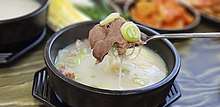Seolleongtang
Seolleongtang[1] (설렁탕) or ox bone soup[1] is a Korean broth tang (soup) made from ox bones (mostly leg bones), brisket and other cuts. Seasoning is generally done at the table according to personal taste by adding salt, ground black pepper, red pepper, minced garlic, or chopped spring onions. It is a local dish of Seoul.[2]
 | |
| Alternative names | Ox bone soup |
|---|---|
| Type | Tang |
| Place of origin | Korea |
| Serving temperature | Warm |
| Main ingredients | Beef bones, head, trotters, knee cartilage, and intestines |
| Korean name | |
| Hangul | 설렁탕 |
|---|---|
| Hanja | 先農湯 |
| Revised Romanization | seolleongtang |
| McCune–Reischauer | sŏllŏngt'ang |
| IPA | [sʌl.lʌŋ.tʰaŋ] |
Seolleongtang is typically simmered over a low flame over a period of several hours to an entire day, to allow the flavor to be gradually extracted from the bones. It has a milky off-white, cloudy appearance and is normally eaten together with rice and several side dishes; the rice is sometimes added directly to the soup.[3]
History and etymology
In the Joseon dynasty, Koreans regularly made nationwide sacrifices to their ancestors, such as Dangun (the legendary founder of the kingdom of Gojoseon). The nationwide sacrifice was called Sŏnnongje (hangul: 선농제; hanja: 先農祭, Sŏnnong meaning "venerated farmer"), and the altar for the sacrifice was called Sŏnnong dan (hangul: 선농단; hanja: 先農壇), which dates back to the Silla Dynasty.[4]
King Seongjong had visited the sacrifice himself, and had eaten a meal with the people of Joseon. To increase the food supply in Joseon, King Seongjong ordered them to invent dishes that could feed the maximum number of people using the fewest ingredients, and seonnongtang (tang meaning "soup") was one of these.[4]
Another historical opinion precedes the Joseon dynasty concerning the origin of seolleongtang. According to this, the food was originated by the Mongolian invasion of Koryo in 13 BC. Mongolian food "Sulen" is sliced and boiled beef with green onions, which developed into seolleongtang in Korea. [5]
Seonnongtang is now called seolleongtang for easier pronunciation. The phonetic values have changed as follows:
- Seonnongtang (선농탕, Sŏnnongt'ang) > Seollongtang (설롱탕, Sŏllongt'ang) > Seolleongtang (설렁탕, Sŏllŏngt'ang)
The first change is a consonant liquidization making the two "N" sounds into softer "L" sounds for easy pronunciation. The second change is a vowel harmonization of the "O" sound affected by the "Ŏ" sound.
Among common misbeliefs related to the dish, the name may come from its snowy white color and hearty taste, so seolleongtang was named "雪濃湯" in hanja (literally "snowy thick soup"). Therefore, several Korean dictionaries say that the hanja spelling such as 雪濃湯 is an incorrect usage for the dish.[6] Nevertheless, the misspelling[7] is used to refer to the soup in hanja.[8][9]
See also
| Wikimedia Commons has media related to Seolleongtang. |
- Galbitang, beef short rib soup
- Samgyetang, chicken ginseng soup
- Haejangguk, soups eaten as a hangover remedy
- Gomguk
- Guk
- Korean cuisine
- List of Korean dishes
- List of soups
References
- (in Korean) "주요 한식명(200개) 로마자 표기 및 번역(영, 중, 일) 표준안" [Standardized Romanizations and Translations (English, Chinese, and Japanese) of (200) Major Korean Dishes] (PDF). National Institute of Korean Language. 2014-07-30. Retrieved 2017-02-16. Lay summary.
- Kim, Violet "Food map: Eat your way around Korea" CNN Go. 6 April 2012. Retrieved 2012-04-12
- Seolleongtang at Doosan Encyclopedia(in Korean)
- (in Korean) Seonnong dan at Doosan Encyclopedia
- Do, H. (2011). 전쟁이 요리한 음식의 역사[History of war and food]. Seoul: Sidaeuichang
- "표준국어대사전 雪濃湯" National Institute of the Korean Language. Retrieved 2007-01-19 (in Korean)
- 風神祭와 先農祭의 민속과 어원, On the Etymological Approach for the Korean Word 'PUNGSINJE' & 'SEONNONGJE' 최창렬, 어학, Vol.16 , pp. 5-19 (1989)
- "你好韓國:充滿傳統趣味的 民俗村" New Tang Dynasty Television. 20 March 2008. Retrieved 2012-04-12 (in Chinese)
- "Regional specialities: Seoul: Seolleongtang" Korea Tourism Organization. 9 January 2006. Retrieved 2012-04-12 (in Chinese)